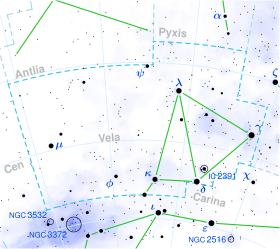| Observation data Epoch J2000 [1] Equinox J2000 [1] | |
|---|---|
| Constellation | Vela |
| HR 3562A | |
| Right ascension | 08h 55m 19.20215s |
| Declination | −45° 02′ 30.0241″ |
| Apparent magnitude (V) | +6.26 [2] |
| HR 3562B | |
| Right ascension | 08h 55m 21.6s [3] |
| Declination | −45° 02′ 52″ [3] |
| Apparent magnitude (V) | +12.639 [4] |
| Characteristics | |
| HR 3562A | |
| Spectral type | B3IV [5] |
| U−B color index | −0.63 [2] |
| B−V color index | −0.16 [2] |
| J−H color index | −0.121 [6] |
| J−K color index | −0.132 [6] |
| Variable type | Slowly pulsating B-type star |
| Astrometry | |
| HR 3562A | |
| Radial velocity (Rv) | 22.0±3.3 [7] km/s |
| Proper motion (μ) | RA: -13.091 [8] mas/yr Dec.: 7.601 [8] mas/yr |
| Parallax (π) | 2.6833±0.0455 mas [8] |
| Distance | 1,220 ± 20 ly (373 ± 6 pc) |
| Absolute magnitude (MV) | −2.55 [4] |
| HR 3562B | |
| Absolute magnitude (MV) | 5.22 [4] |
| Orbit [4] | |
| Primary | HR 3562A |
| Companion | HR 3562B |
| Semi-major axis (a) | 35.0" (10024 AU ) |
| Details [4] | |
| HR 3562A | |
| Mass | 5.644±0.282 [5] M☉ |
| Radius | 5.648±0.282 [5] R☉ |
| Luminosity | 832 L☉ |
| Surface gravity (log g) | 3.67 or 4.01 cgs |
| Temperature | 16,982 K |
| Rotational velocity (v sin i) | 5 [9] km/s |
| Age | 36-38 Myr |
| HR 3562B | |
| Luminosity | 0.64 [a] L☉ |
| Temperature | 5,613 K |
| Age | 50-110 Myr |
| Other designations | |
| WDS 08553-4503AB | |
| HR 3562A: IY Velorum, CD−44° 4951, CPD−44° 3226, Gaia DR3 5331355759365786368, GC 12349, HD 76566, HIP 43807, HR 3562A, SAO 220664, PPM 313785, WDS J08553-4503A, TIC 30125083, TYC 8152-139-1, GSC 08152-00139, 2MASS J08551918-4502298 [1] | |
| HR 3562B: CD−44° 4951B, CPD−44° 3226B, HD 76566B, WDS J08553-4503B [3] | |
| Database references | |
| SIMBAD | A |
| B | |
HR 3562 (HD 76566) is a visual binary consisting of a bluish-white hued variable star and a Sun-like secondary star in the southern constellation of Vela. It has the variable-star designation IY Velorum (abbreviated to IY Vel). With an apparent magnitude of 6.26, the brighter primary is near the limit for naked eye visibility. The fainter companion has an apparent magnitude of 12.639 [4] and can be observed with a telescope with an aperture of 76 mm or wider. [10] It is located approximately 373 parsecs (1,220 ly) distant according to Gaia EDR3 parallax measurements, and is receding away from the Solar System at a heliocentric radial velocity of 22.0 km/s.

